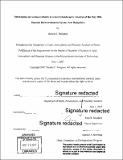Mechanisms governing avulsions in transient landscapes : analysis of the May 2006 Suncook River avulsion in Epsom, New Hampshire
Author(s)
Perignon, Mariela C
DownloadFull printable version (8.528Mb)
Alternative title
Analysis of the May 2006 Suncook River avulsion in Epsom, New Hampshire
Other Contributors
Massachusetts Institute of Technology. Department of Earth, Atmospheric, and Planetary Sciences.
Advisor
John B. Southard.
Terms of use
Metadata
Show full item recordAbstract
Avulsions, or rapid changes in the location of a river, usually occur in environments such as deltas, floodplains, and alluvial fans where net-deposition can raise the bed of the river above its floodplain. Avulsions are less frequent in transient landscapes, such as New England, where topography and hydrography are still responding to recent glaciation. One of these rare avulsions occurred during a 100-year flood on the Suncook River, Epsom, NH, between May 14 and 15,2006. We studied the Suncook River event to develop a model for the drivers of avulsions in transient landscapes. We suggest that a strong substrate in the parent channel, such as bedrock or immobile boulders, can facilitate an avulsion by preventing incision and driving water overbank. Easily erodible substrates in the path of the new channel can also contribute to avulsions by allowing a knickpoint to migrate quickly upstream and create a channel with a more favorable slope during a single flood. Based on Slingerland and Smith's (2004) model, we also propose that a low water-surface slope in the parent channel could be a direct driver for avulsions. In the Suncook River, this low water-surface slope was created in the backwater of a small mill dam in the parent channel. A 200-year flood that occurred in the Suncook River in 1936 did not create an avulsion. We suggest that ice floats could have damaged the dam and increased the water-surface slope of the parent channel, making an avulsion less favorable and reducing the depth of water flowing overbank. The topography in the path of the 2006 avulsion, which was lowered by activity in a sand pit starting in the 1960s, probably prevented water from finding a new path. We believe that these anthropogenic modifications directly contributed to the occurrence of the May 2006 avulsion in the Suncook River. These conditions are common throughout New England, and could increase the risk of avulsions in the region.
Description
Thesis: S.B., Massachusetts Institute of Technology, Department of Earth, Atmospheric, and Planetary Sciences, 2007. Cataloged from PDF version of thesis. Includes bibliographical references (pages 60-66).
Date issued
2007Department
Massachusetts Institute of Technology. Department of Earth, Atmospheric, and Planetary SciencesPublisher
Massachusetts Institute of Technology
Keywords
Earth, Atmospheric, and Planetary Sciences.